The First Diamond Mine in Europe? 50 km south of the Arctic Circle, Arctic Star aims to make that happen!
Full size / A group of investors from Europe and Canada visited the Timantti Diamond Project near Kuusamo, Finland in May 2019 (the picture shows part of the Grey Wolf Kimberlite excavated after less than 2 m of overburden).
Rockstone has been following Arctic Star Exploration Corp. for several years now. In light of the recent discovery in Finland of the world‘s newest diamond field, the time has come to visit the project and meet the team behind Arctic Star.
Although I am already a shareholder of Arctic Star, I must admit that the site-visit somewhat changed my perspective about this project and that I plan to participate in the next equity financing to increase my position. Frankly put, I don‘t want to miss the chance when the big picture gets recognized by the market as not only I, but the entire team behind Arctic Star, believes that this has great potential to become a diamond mine, which actually would be the first ever diamond producer in the European Union.
When you watch the short site-visit video (3 minutes), you can only catch a glimpse of the project and what we have actually seen and discussed during our 4 day stay in Finland:
Watch on YouTube: https://youtu.be/prncOgcjUH8
When you watch the presentation by Hugh O‘Brien from the Geological Survey of Finland (GTK) in combination with the presentation by Roy Spencer, you may also come to the conclusion that this diamond project has encouraging signs to become a success, especially when considering that the people behind this project are highly experienced and have been extremely successful in diamond exploration (Buddy Doyle and Roy Spencer have discovered multi-billion-dollar diamond mines in Canada and Russia). Now, they are fully dedicated and eager to find the next diamond mine – this time in Finland, to be precise on the same craton where Roy discovered the Grib Diamond Pipe in Russia approximately 450 km away.
Watch on YouTube: https://youtu.be/BH4p3dCxMaI
About Dr. Hugh O‘Brien (Senior Research Scientist at Geology Survey of Finland, GTK)
After his Bachelor of Science degree in Geology at the University of Minnesota in 1982 and receiving a Ph.D. in Geology from the University of Washington in 1988, Dr. O‘Brien went straight to Finland to work several years as a Research Scientist at the Geological Survey of Finland (GTK). After a 5 year stint back in the US, he returned to GTK in 1997 as a Senior Research Scientist and started consulting for various diamond exploration and production companies.
Watch on YouTube: https://youtu.be/-VQmmplM7xY
About Roy Spencer (Finland Country Manager and Director of Arctic Star Exploration Corp.)
Roy Spencer (P.Geo.) joined De Beers in 1966 and has been involved with exploration and deposit evaluation for gemstones and other commodities throughout his career. As technical director of Peregrine Diamonds Ltd., he discovered the first kimberlites on the Pilbara Craton in Western Australia in 1989, and as Leader of the Owners Team for Archangel Diamond Corp. he was largely responsible for the discovery of the world-class Grib Kimberlite in northern Russia (February 1996). In 1998, Roy created and raised the seed finance for Ilmari Exploration Oy to explore for gold, base metals and diamonds on the Karelian Craton in Finland. Ilmari went public in 2000 and discovered the Lentiira kimberlite cluster in central Finland in 2003. In 2006, as CEO of London-based diamond explorer European Diamonds, Roy led the Owners Team which brought the Liqhobong Kimberlite (Lesotho) into commercial production on time and under budget. In mid-2007, Roy left European Diamonds, a company which had evolved into a successful mid-tier diamond producer and marketer after having raised £23 million over a 6-year period. Since that time, Roy has continued in gemstone exploration and deposit evaluation in Africa, Finland and western Russia for a variety of junior and senior mining companies. Roy‘s tertiary education was at the University of Natal and Rhodes University in South Africa, and is a member of the Geological Society of South Africa and a Fellow of the Aus.I.M.M.
It‘s the People that Make it Happen
Arctic Star has some of the best people to advance the Timantti (Finnish for "Diamond") Project in Finland with state-of-the-art exploration techniques, which have the objective of establishing a world-class diamond deposit in the Finnish portion of the Karelian Craton – comparable to the world-class, multi-billion-dollar diamond mines found on the Russian portion of the same Karelian Craton. This highly technical team is not only experienced with diamonds exploration but has also had great successes:

Full size
Buddy Doyle (VP of Exploration and Director of Arctic Star Exploration Corp.) worked for Rio Tinto for over 23 years, where he was a key member of the team which discovered the multi-million-ounce Minifie Gold Deposits at Lihir in 1987. He also led the team which discovered the Diavik Diamond Deposit in Canada in 1994. Today, Diavik is a multi-billion-dollar diamond mine, one of the largest in North America.

Full size
As already mentioned above, Roy Spencer discovered the Grib Diamond Pipe in Russia, located on the same geological belt (Baltic Shield / Karelian Craton) as the Timantti Diamond Field about 450 km from Kuusamo in Finland. Roy lives in London, UK, from where he can get direct flights (seasonal) to Kuusamo or via Helsinki (daily).
Arctic Star also has Terhi Tulenheimo, an experienced geologist who lives in Finland, representing Arctic Star‘s Finnish subsidiary Foriet Oy. As she has been working with Roy for almost 20 years, she is an invaluable asset overseeing all activities locally.
With Hugh O‘Brien working for the Geological Survey of Finland (GTK), Arctic Star has an independent consultant highly experienced and specialized in diamonds and geology. Hugh has been living in Finland for more than 25 years and has good contacts with the government and with Finnish exploration and mining companies.
Arctic Star‘s President and CEO, Patrick Power, pulls all the strings from Vancouver, Canada. He has been involved in the diamonds exploration business for many decades, has a large network of contacts within the industry, and is key for the company to raise funds as an adept financier. His wealth of experience as a savvy deal-maker will be key for the company going forward. See video interview here.
We also had the chance to meet Binny Jassal during the site-visit, who is Arctic Star‘s CFO with +20 years of accounting experience and an important member of the team working on the financial and corporate side of the operations.
Arctic Star‘s Director, Sean Charland, was also on site, a seasoned communications professional with experience in marketing and financings (he has helped to raise over $150 million CAD during his career), having a large network of contacts within the financial sector in North America and Europe.
Besides a group of investors from Europe and Canada, Eric Lemieux also participated in the site-visit. He is a Quebec geologist with 25 years of experience in mineral exploration, project valuation and expertise in gold, base-metal, diamond, uranium and Quebec shale gas and oil exploration. Read Eric‘s report "Site Visit – Timantti advancing gradually as a possible tantalizing diamond play"

Full size / Location of the Timantti Project near Kuusamo in Finland as well as the Grib and Lomonosov Diamond Mines in Russia.
Initial Results
Most importantly, it is key to understand that the results thus far obtained from exploration (sampling from excavating, trenching and drilling) are very encouraging for the first phase of exploration.
As Roy summarized in his presentation: "A total of 950 kg of core from the first 3 kimberlites produced 1,700 diamonds. I have been in this business for a few years now and this is about as good of a result I have ever seen."
It is absolutely normal that "only" micro-diamonds have been found so far as larger stones are typically not absent but distributed erratically throughout a diamondiferous kimberlite body. Even the most productive diamond mines in the world don‘t produce large stones from every ton of kimberlite processed, though the average grade may be a carat per ton or more.
Hugh explained in his site-visit presentation that “Economic ore can be as little as a few carats per 100 tons – the size of your small fingernail in 1 cubic meter of rock or the weight of a 2 Euro coin in 100 tons of rock. Consequently, it is very rare to find diamonds in exploration samples“, which normally are in the range of a few tens of kilograms. However, “luckily other mantle minerals associated with diamond are much more common in kimberlite“, which are indicative that diamonds may be present in the target kimberlite body. DIM (Diamond Indicator Minerals), such as pyrope-garnets and chromite, are a great sign that diamonds are near-by – both of which Arctic Star has found after digging up some kimberlite samples near surface (less than 2 m of overburden) at the Grey Wolf Kimberlite during our site-visit.
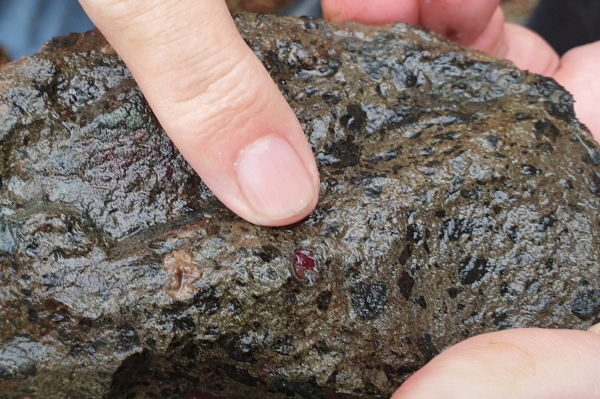
Full size / A fairly large pyrope-garnet crystal in kimberlite matrix found near surface at the Grey Wolf Kimberlite during the site-visit.
What I have also learned during the site-visit is that when you look at the kimberlite rock, the size of olivine crystals is indicative of how large the diamonds could be.

Full size / Olivine is a common mineral in the earth‘s subsurface and the primary component of the earth‘s upper mantle some 150 km below surface, where diamonds also originate from. Olivines and diamonds are carried from the upper mantle toward the surface by the kimberlite magma, finally erupting as small volcanoes whose remnants are referred to as kimberlite pipes. The back side of the kimberlite sample shown above included a pyrope-garnet (see previously shown picture and also the 3-minute video).
As you can see in the above picture, there are not only plenty of olivine crystals in the kimberlite but also pretty big ones, which is an indication that diamonds with similar sizes may be present, scattered throughout the kimberlite body. Consequently, diamond explorers must do bulk sampling of many hundreds to thousands of tons of kimberlite to get an indication of the diamond size distribution within the kimberlite body.
Instead of now doing bulk sampling of the already discovered 4 kimberlites, Arctic Star has decided to first look for more kimberlites on its property, because kimberlites typically occur in clusters, i.e. groups of many kimberlite bodies in proximity. By first finding as many kimberlites as possible, and sampling those for DIM and micro-diamonds, allows Arctic Star to thereafter decide which kimberlites are interpreted to be the most promising for bulk sampling. Keep in mind that bulk sampling is a costly endeavour and considering that we don‘t have a bull-market in diamonds or commodities at the moment, the company needs to be savvy on how to spend its funds.
No Competition
Back in the good days, a new diamond field discovery as such in Finland by Arctic Star would have likely resulted not only in much larger investors‘ interest but also in more competition surrounding any new discovery. Normally, an acquisition/staking-rush in the region would occur after an initial discovery – a clear sign for investors that something big could be going on. Certainly, this would have been helpful for Arctic Star getting more attention, but on the other hand the company thought it to be more important to get the jump early on any potentially evolving competition by securing a district-scale land package, because there is something every diamond explorer knows by heart as Roy explained:
“Kimberlites are likely to occur in fields – also known as clusters – which typically contain 30 or more separate kimberlites. The Wolf kimberlites are just the first discoveries in a more extensive cluster. There is good evidence for the existence of this field in the public domain. This data shows regional distribution of kimberlitic indicator minerals and diamonds in surficial tills. The Exploration Reservation will allow Arctic Star to explore the entire region.”
Arctic Star has secured a very large land package of around 2,000 km2 (1,171 hectares in 2 Exploration Permits over the Wolf Kimberlites plus 193,700 hectares in granted "Exploration Reservations" giving Arctic Star the exclusive claim staking rights for 2 years).
Media Coverage
At least the Finnish media is excited about the diamond discoveries near Kuusamo as below newspaper articles demonstrate:
Koillissanomat (April 20, 2018)
 Full size / Arctic Star‘s diamond discovery made the front page of the Koillissanomat newspaper: "Vaimosuolla kaivetaan timantteja" ("Digging diamonds at Vaimosuo") while the article on page 2 is titled "Kuusamosta löytyi timantteja" ("Diamonds found in Kuusamo"). Like most of the people living in the Kuusamo area, Hannu Tuovila, a local who lives 1 km from the Wolf Kimberlites, has a positive attitude towards mining. Hannu commented in the article: "Jos siihen tulisi kaivos, niin silti ajetaan koiravaljakoilla" ("A mine wouldn‘t stop us organizing dog-sled rides here"). After visiting the property, we had lunch at Hannu‘s near-by cabin Loma-Lopotti.
Full size / Arctic Star‘s diamond discovery made the front page of the Koillissanomat newspaper: "Vaimosuolla kaivetaan timantteja" ("Digging diamonds at Vaimosuo") while the article on page 2 is titled "Kuusamosta löytyi timantteja" ("Diamonds found in Kuusamo"). Like most of the people living in the Kuusamo area, Hannu Tuovila, a local who lives 1 km from the Wolf Kimberlites, has a positive attitude towards mining. Hannu commented in the article: "Jos siihen tulisi kaivos, niin silti ajetaan koiravaljakoilla" ("A mine wouldn‘t stop us organizing dog-sled rides here"). After visiting the property, we had lunch at Hannu‘s near-by cabin Loma-Lopotti.
Koillissanomat (April 23, 2018)
Full size / This follow-up article in the Koillissanomat newspaper included an interview with Matti Tyni: "Asiantuntija: Timanttikaivosten kimberliitissä ei ole uraania." ("Expert: There is no Uranium in kimberlites") as Mika Flöjt from the Green Party claimed in the first article (April 20, 2018) that there would be uranium associated with diamond mines, obviously trying to scare the locals about diamond mining in the area. The expert Matti Tyni debunked this myth.
Koillissanomat (April 26, 2018)

Full size / A few days later, another follow-up article was published in the Koillissanomat newspaper, including an interview with Roy Spencer who said: "Timantit irrotetaan ilman kemikaaleja" ("Diamonds are separated without chemicals"). He was introduced as "Timanttiyhtiön johtaja Roy Spencer löytänyt aiemmin miljardiesiintymän" ("Roy Spencer, Manager of the diamond company, has found a world-class diamond deposit earlier in his career"), showing the Rockstone report "Another Grib Diamond Mine in Finland?" (Roy discovered the Grib Diamond Deposit).
No Chemicals in Diamond Mining
As Roy pointed out in the above newspaper interview, there are no chemicals involved with diamond mining. This is in stark contrast to most other commodity mines (e.g. precious and base metals, rare earths, or hard-rock lithium), where acids are required to separate the metals from each other and/or the host rock. Diamond mining is a very straight-forward process with little impact on the environment. After removing the kimberlite rock (either by an open-pit or by underground mining methods), the rock is only crushed to free the diamonds. This is a relatively clean and safe procedure when compared to metals mining and processing. As such, CAPEX (capital expenditures) and OPEX (operating expenditures) can be minimized to operate a diamond mine.
Remarkable Location
Another major factor impacting CAPEX and OPEX is the location and infrastructure of any exploration and mining project. As Roy pointed out at the very end of his presentation, it costs about $2 billion CAD to set up a mine in Canada, simply because "most Canadian diamond mines are located many hundreds of kms from logistical centres & grid power". Consequently, "Canadian mines require a grade of +1 cpt [carat per ton] and a value of +$100/ct" to be economic", Roy figured out and added that "these kimberlites are exceedingly rare geological features".
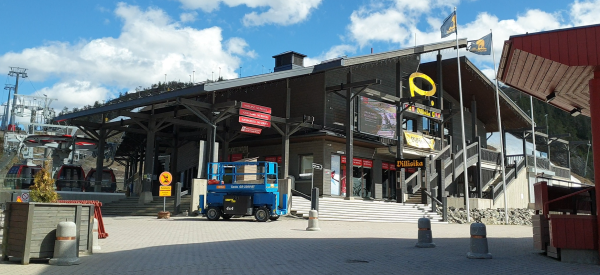
Full size / The Timantti Property is located just a few kilometers from the world-famous ski resort Ruka Village (pictured above), 17 km from Kuusamo and 400 m off the highway. The property can be reached from Kuusamo International Airport within a 25-minute drive. There is even a bus stop 2 km from the property. The municipality of Kuusamo (population: 15,800) lies on the crossroads of 2 major highways and is part of the national energy grid, whereas there is also a 6 MW electricity grid in town which uses sawmill rejects. The main industries are tourism (around 1 million visitors annually), forestry and reindeer herding. Ruka is Finland´s most popular ski resort and "has turned into a diverse centre whose year-round usage is growing", according to Wikipedia. "In winter there are for example Nordic skiing World Cup competitions. FIS Nordic Combined season starts yearly in Ruka (Nordic Opening). There are also annual national competitions in alpine and freestyle skiing, and there have been international competitions in these sports, too. Ruka has one of the longest ski seasons in Europe, starting usually in October and ending in June. During the main season ski lifts are open daily from 9.30 am until 7 pm. There´s also night skiing on Fridays 7-11 pm (usually from December until mid-April)... In the summer the snow melts and Ruka becomes a hiking and mountain biking centre with the Oulanka National Park and world-famous Karhunkierros, 80 km hiking trail, on its doorstep. Other activities on offer are canoeing, white water rafting, fishing, birdwatching, hiking with huskies, lake cruises, bear watching, water skiing and ATV safaris."

Full size
In other words: Infrastructure is excellent, or as Roy said: "The Kuusamo diamond field is in a far more benign logistical environment" when compared to Canadian diamond mines. "There are no ‘winter‘ roads in Finland", Roy emphasized and pointed out that "This will have a major effect on the investment required to develop a diamond mine in this region, in particular in the cost of capital AND also on the grade that is needed to define an economic diamond mine". Roy estimated that in the Kuusamo area it may cost only 10% ($200 million CAD?) of what it takes to bring a diamond deposit into production in Canada ($2 billion CAD). Therefore, the required average grade and value of the diamonds in Finland should be much lower to be economic. Roy concluded: "In the last 40 years that I have been in this business, I have never come across anything like this."
Bottom Line
Patrick Power pointed out during the site-visit: "In 1995, there were 151 TSX-listed companies looking for diamonds. Today, there are only 5." For many years, new diamond field discoveries have become very rare and there was no bull-market in diamonds or commodities. On the other hand, there is also something positive attributed to this circumstance: It has given Arctic Star the ability to basically chose the geological and jurisdictional settings in the world that they want, because there is little serious competition out there anymore.
I don‘t know of any other place on the planet where a new diamond field is being discovered and delineated at the very moment as most of the favorable places for kimberlites have already been investigated. Finland appears to be the latest "hot spot" for the discovery and development of a new diamond field. When you look at below slide from Hugh‘s presentation, you can see that there are not many places in the world favorable for diamonds and that Finland is one of the last places with pristine chances of finding a new diamond mine.

Full size / The thickest parts of the earth‘s rigid crust (highlighted in blue) are some of the best places to look for diamonds, because these delicate gems can not "survive" for millions and billions of years in the hot mantle but only in those few old, cold, deep and rigid bodies of mantle, such as the Karelian Craton in Finland and Russia. (Source: Presentation by Hugh O‘Brien, Geological Survey of Finland; May 30, 2019)
As per the following slide from Hugh‘s presentation, the Arkhangelsk diamond area, which includes the producing Lomonosov Mine, hosts a group/cluster of kimberlite bodies, some of which are small and some of which do not contain any diamonds at all or do not contain any commercial-sized diamonds. For example, the 1 km large Sooksoma Kimberlite does not contain any diamonds. For such reasons, Arctic Star feels it‘s important to first find more kimberlites on its property, whereafter bulk sampling is planned for the best ones.

Full size / Surface outlines of some of the kimberlite pipe discoveries in the Arkhangelsk Area. Source: Presentation by Hugh O‘Brien, Geological Survey of Finland; May 30, 2019
According to the following slide from Hugh‘s presentation: Of all the kimberlites identified in the Arkhangelsk diamond area in Russia, only the Arkhangelskaya Kimberlite hosts high diamond grades of around 1 carat/ton, while the Karpinskaya – I Kimberlite averages 0.65 carats/ton (probably still very economic). Other kimberlites have uneconomic grades as low as 0.09 carats/ton (Pomorskaya Kimberlite). In essence, not every diamondiferous kimberlite hosts economic grades, hence making it more important to find as many kimberlites in the field as possible to then decide which ones are most prospective to contain economic grades.
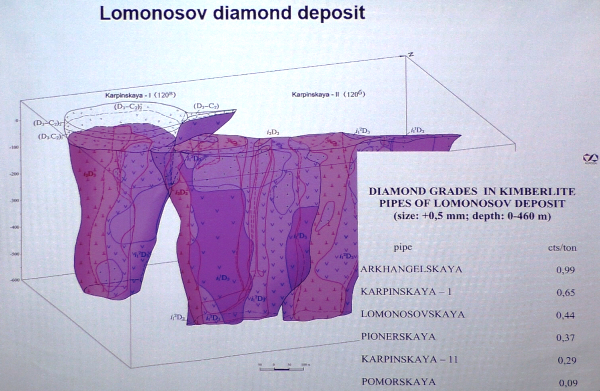
Full size / Source: Presentation by Hugh O‘Brien, Geological Survey of Finland; May 30, 2019

Full size / Simplified cross-section of the Karelian lithosphere (Lehtonen, 2009); Source: Presentation by Hugh O‘Brien, Geological Survey of Finland; May 30, 2019; see also Technical Report as of June 20, 2017
As Roy noted in his presentation, a group of prospectors found a 2.8 carat diamond (from till sampling) across the Russian border, which got transported away from its source by glaciers / ice sheets some 10,000 years ago: "All of these till sheets that cover this whole area [in Russia] have come from Finland. So, I am pretty confident that most of the indicator minerals and certainly the diamonds that we found up here [in Russia], have not come from Russia at all, they have come from Finland." This 2.8 carat diamond find (a very, very rare event) demonstrates that there may also exist large diamonds in the Finnish part of the Karelian Craton, the source of which has yet to be found.
The ice sheets mentioned can be followed all the way to the Arkhangelsk diamond fields (Lomonosov and Grib Mines) some 450 km east of Kuusamo. As these huge ice sheets moved from the west to the east, they dragged along not only indicator minerals and diamonds from kimberlite sources but also rocks and sediments from the surface of the area. In this context, note Roy mentioning that the Arkhangelsk diamond field has 65 m of completely barren sediments sitting above the kimberlites, so there was a good portion of luck involved in discovering these. It‘s a completely different picture in the Kuusamo diamond field, where the kimberlites discovered so far have as little as 1-3 m of overburden, making exploration less dependent on luck. The kimberlites on the Timantti Property are easier to excavate and drill due their near-surface occurrence.

Full size / Source: Presentation by Roy Spencer; May 30, 2019 (after Svendren et al, 2004)
What‘s next?
As Roy stated in his presentation: "I am a great believer in magnetics" and showed the following image – the results of a magnetics survey over the area where the 3 kimberlites (Grey, Black and White Wolf) have been discovered near surface and in proximity to each other:
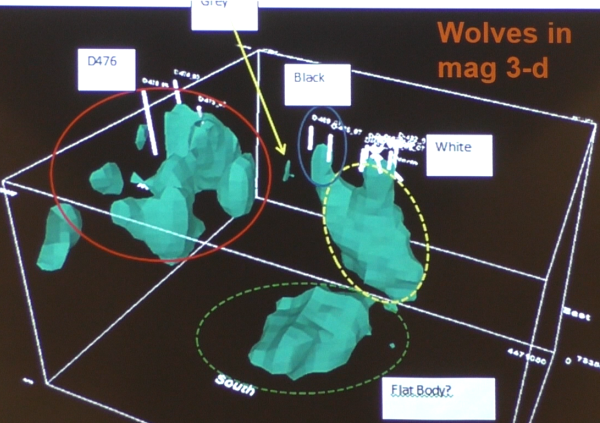
Full size / (Source: Presentation by Roy Spencer; May 30, 2019)
The distance between the Black and White Wolf is about 50 m, whereas magnetics suggests that the two kimberlite bodies at the surface connect at depth to form one body. The white lines show past drilling (up to 50 m from surface) – and that virtually only the surface was scratched / or the top of the kimberlite – because all of the green area is predicted to be kimberlitic. There appears to be a flat body beneath Black/White Wolf, so it would be highly interesting to drill down Black/White Wolf to eventually hit (and sample) that flat looking body. A few hundred meters to the west is D476, which has the exact same magnetics signature as both the bodies in the east. Overall, this is "a very, very persuasive argument that at least we should be focussing on this area to see what the rest of the green areas are all about".
Besides the above shown area of the 3 Wolves, there are several other high-priority magnetics targets to the west, north-west and east, where Arctic Star is looking at the moment and working in the field, which is planned to be part of a much more extensive excavator and drilling program going to test all of those anomalies.
In conclusion, Arctic Star is getting ready for more discoveries. This is only the beginning, but a fabulous start to say the least – even if the market does not yet recognize the potential.

Full size / On the flight back from Kuusamo to Zurich, I reflected having travelled the world for many years in search of the next big winner and being invested in a bunch of junior exploration and mining companies with projects scattered all over this planet. I imagined the Timantti Project becoming a diamond mine – in Europe, which place I call home – and thought "Oh dear, maybe one of the most compelling success stories is happening right now, right here at home. I better load up and fasten my seat belts as this could take off any time now."
Previous Coverage on the Timantti Project in Finland
"Diamonds in Finland: Searching for the Leader of the Wolf Pack"
"Arctic Star wows with latest drill results from its Timantti Diamond Project in Finland"
"Diamond Discovery in Finland"
"Time to Bet on 4 High-Carat Hot-Shots"
"Another Grib Diamond Mine in Finland?"
Company Details

Arctic Star Exploration Corp.
1111 West Georgia Street
Vancouver, B.C. V6E 4M3, Canada
Phone: +1 604 689 1799
Email: info@arcticstar.ca
www.arcticstar.ca
Shares Issued & Outstanding: 128,514,274

Chart
Canadian Symbol (TSX.V): ADD
Current Price: $0.05 CAD (07/03/2019)
Market Capitalization: $6 Million CAD
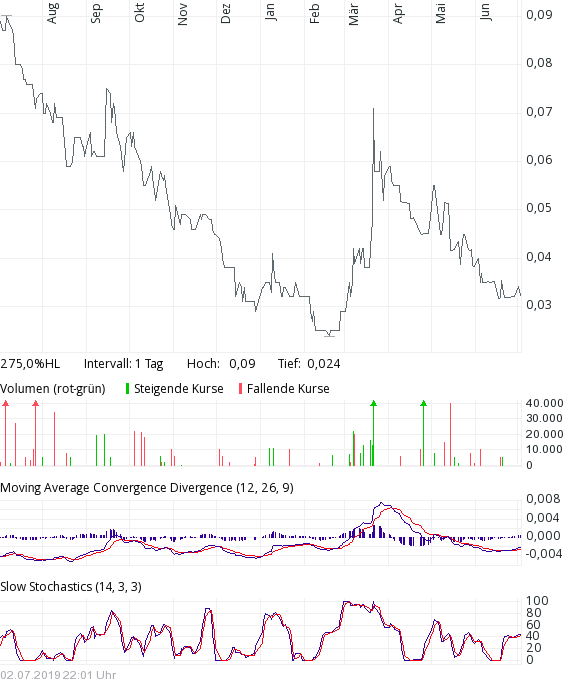
Chart
German Symbol / WKN (Tradegate): 82A1 / A2DFY5
Current Price: €0.032 EUR (07/03/2019)
Market Capitalization: €4 Million EUR
Contact:
Stephan Bogner (Dipl. Kfm., FH)
Rockstone Research
8260 Stein am Rhein, Switzerland
+41-44-5862323
info@rockstone-research.com
www.rockstone-research.com
Disclaimer: This report contains forward-looking information or forward-looking statements (collectively "forward-looking information") within the meaning of applicable securities laws. Forward-looking information is typically identified by words such as: "believe", "expect", "anticipate", "intend", "estimate", "potentially" and similar expressions, or are those, which, by their nature, refer to future events. Rockstone Research, Zimtu Capital Corp., and Arctic Star Exploration Corp. caution investors that any forward-looking information provided herein is not a guarantee of future results or performance, and that actual results may differ materially from those in forward-looking information as a result of various factors. The reader is referred to the Arctic Star Exploration Corp.’s public filings for a more complete discussion of such risk factors and their potential effects which may be accessed through the Arctic Star Exploration Corp.´s profile on SEDAR at www.sedar.com. Please read the full disclaimer within the full research report as a PDF (here) as fundamental risks and conflicts of interest exist. The author, Stephan Bogner, holds a long position in Arctic Star Exploration Corp. and is being paid by Zimtu Capital Corp., which company also holds a long position in Arctic Star Exploration Corp., whereas the featured company Arctic Star Exploration Corp. pays Zimtu Capital Corp. for the preparation, publication and additional distribution of this report. Arctic Star has also paid the travel-related expenses incurred by the author to visit Arctic Star’s Timantti Project in Finland.